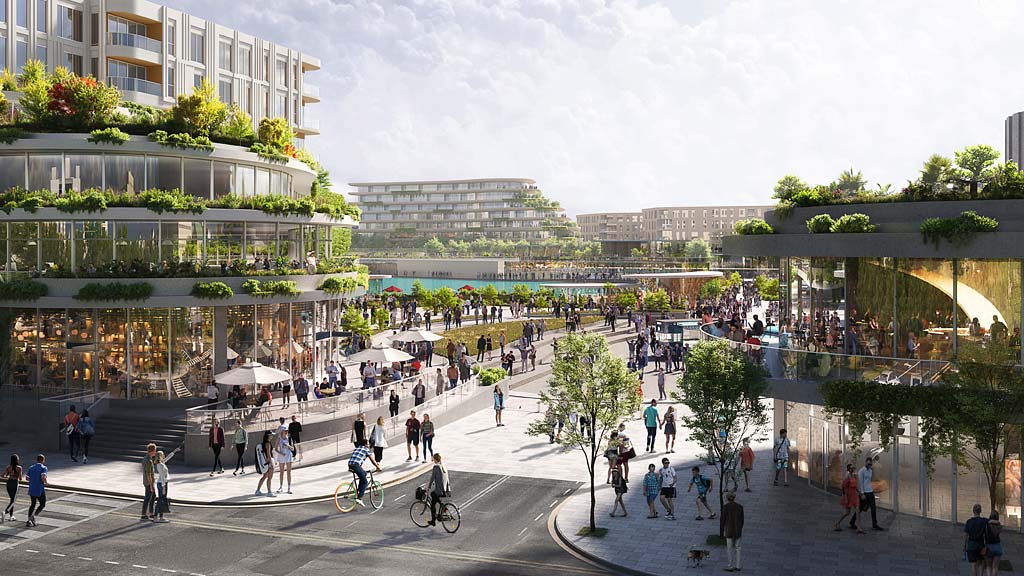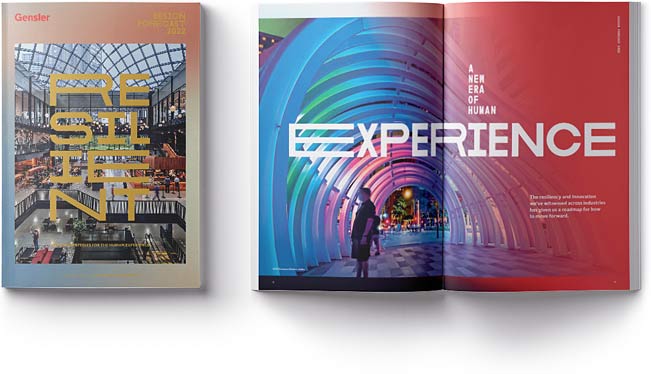DESIGN FORECAST® 2022
After almost two years of pandemic-infused stops and starts, an enduring resilience is defining the built environment. We’re witnessing optimistic investments and plans that reflect the most influential issues we’re facing today in climate change, inclusion, and community. This optimism is happening in spite of the pandemic, not because we’ve gotten past it.
This year’s Design Forecast focuses on design strategies that will define the future of the human experience. You’ll find strategic advice, research, and projects from all 28 of Gensler’s practice areas. We hope these design trends and insights will help you prepare for a new era in which the most valued places are the ones that put people first.

FUTURE
OF
ENHANCING THE URBAN EXPERIENCE
Great neighborhoods, employment opportunities, affordability, and multimodal transportation are the foundations of a great city. But cities have their work cut out for them. The lasting impacts of COVID, and the health scare that came with the virus, have led people to question urban living. To position themselves as places where people want to live, cities must embrace design as a way to create better experiences.
Health and wellness will continue to be a priority. To attract talent, cities and urban developers must focus on affordability and racial and socioeconomic disparities. Concepts like the 20-minute neighborhood will continue to gain traction, as will new, more accessible modes of transportation.
Finally, as the effects of climate change cause larger and more damaging weather events, investments in weather mitigation strategies and sustainable building practices will continue to reshape the urban experience for the better.
FUTURE
OF
THE WORKPLACE EXPERIENCE
The workplace is changing at an unprecedented pace. Across the globe, we’ve seen a fundamental shift in how and where work happens. Amid these profound shifts, organizations, developers, and landlords want to know what they can do to optimize their real estate.
What will set them apart is the experience they design for tenants and employees. We know that workers around the world still place a great deal of value in the physical workplace for social interaction, mentorship, deep concentration, and collaborative work. We also know that to compete in a war for talent, companies must also support an ecosystem of workspaces — both in and out of the office — where talent can thrive.
This is an opportunity to rethink the physical workplace to offer a unique and fulfilling experience that can attract talent, whether that’s through new technologies or new types of spaces.
FUTURE
OF
CREATING AN AUTHENTIC COMMUNITY EXPERIENCE
Lifestyle brands have long taken pride in having a deep understanding of their consumers’ needs and expectations. Today, that’s as important as it’s ever been, especially because of the momentous shifts the world has experienced in the past two years due to the impacts of COVID, climate change, and social equity.
For lifestyle brands to succeed and deliver better experiences, they must understand this new context and be better at anticipating what’s next. At the top of the list for brands looking to attract and keep consumers’ attention: community, belonging, and cultural relevancy.
Lifestyle companies will increasingly look to design spaces that can be flexible and multipurpose in order to serve multiple functions for the people and communities they’re in.
FUTURE
OF
DESIGNING A HEALTHIER HUMAN EXPERIENCE
Awareness of how the built environment impacts human health is at an all-time high. As humanity continues to face several formidable challenges directly related to health, this awareness gives us hope. Environments can be a tool with which to make people healthier, a fact that forward-thinking healthcare providers, science organizations, and mission-driven companies are recognizing.
In the coming years, wellness practices will grow to become the touchstones of successful cultures. Investment in resilient design solutions will spike as organizations look to shore up operations against external shocks and accommodate new technologies to future-proof their operations. As digital and physical worlds blend, it will be crucial for design to emphasize our common humanity and shared purpose.
The context for these trends is one unignorable demographic shift: the aging of the population that will soon place unprecedented demands on all sectors to support a healthy and intergenerational future.
